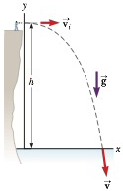
Concept explainers
A student stands at the edge of a cliff and throws a stone horizontally over the edge with a speed of vi = 18.0 m/s. The cliff is h = 50.0 m above a body of water as shown in Figure P4.13. (a) What are the coordinates of the initial position of the stone? (b) What are the components of the initial velocity of the stone? (c) What is the appropriate analysis model for the vertical motion of the stone? (d) What is the appropriate analysis model for the horizontal motion of the stone? (e) Write symbolic equations for the x and y components of the velocity of the stone as a function of time. (f) Write symbolic equations for the position of the stone as a function of time. (g) How long after being released does the stone strike the water below the cliff? (h) With what speed and angle of impact does the stone land?
Figure P4.13

(a)
The coordinates of the initial position of the stone.
Answer to Problem 13P
The coordinates of the initial position of the stone is
Explanation of Solution
The speed of stone is
Write the expression for the initial x coordinate of stone
Here,
Write the expression for the initial y coordinate at the top of the cliff
Here,
Conclusion:
Therefore, the coordinates of the initial position of the stone is
(b)
The components of the initial velocity of the stone.
Answer to Problem 13P
The components of the initial velocity of the stone are
Explanation of Solution
Write the expression for the initial velocity of stone in x direction
Here,
Write the expression for the initial velocity of stone in y direction
Here,
Conclusion:
Therefore, the initial components of the velocity of the stone are
(c)
A model that explains the vertical motion of the stone.
Answer to Problem 13P
In the
Explanation of Solution
The vertical motion of the stone is governed by a free fall motion under constant acceleration
Thus, the motion in the
Conclusion:
Therefore, in the y direction the acceleration is constant.
(d)
A model that explains the horizontal motion of the stone.
Answer to Problem 13P
In the x direction the velocity is constant.
Explanation of Solution
In the
Thus, the motion in the
Conclusion:
Therefore, in the x direction, motion is due to constant velocity motion.
(e)
The symbolic equation for the x and y component of the velocity as a function of time.
Answer to Problem 13P
The x and y component of the velocity are
Explanation of Solution
In the
The final velocity of stone in x direction is same as the initial velocity in the
Write the relation between the final and initial velocity in the x-direction,
Here,
The velocity in x direction does not depend on time.
In the
Write the expression for final velocity in the y-direction
Here,
Conclusion:
Substitute
Therefore, the x and y component of the velocity are
(f)
The symbolic equation for the x and y component for the position as a function of time.
Answer to Problem 13P
The x and y component of the position are
Explanation of Solution
Write the expression for the position of stone in x direction
Here,
Write the expression for the position of stone in y direction
Here,
Conclusion:
Substitute
Substitute
Therefore, the x and y component of the position are
(g)
The time for the stone to strike the water below the cliff.
Answer to Problem 13P
The time for the stone to strike the water below the cliff is
Explanation of Solution
Write the formula to calculate time
Conclusion:
Substitute
Therefore, the time for the stone to strike the water below the cliff is
(h)
The speed and angle with which the stone land.
Answer to Problem 13P
The speed of the stone is
Explanation of Solution
Write the expression to calculate velocity,
Substitute
Write the formula to calculate speed of stone land
Here,
Write the expression to calculate angle of stone land
Conclusion:
Substitute
Therefore, the speed of the stone at the time of land is
Substitute
Therefore, the angle of the stone land is
Want to see more full solutions like this?
Chapter 4 Solutions
Bundle: Physics for Scientists and Engineers, Volume 2, Loose-leaf Version, 10th + WebAssign Printed Access Card for Serway/Jewett's Physics for Scientists and Engineers, 10th, Multi-Term
- Olympus Mons on Mars is the largest volcano in the solar system, at a height of 25 km and with a radius of 312 km. If you are standing on the summit, with what Initial velocity would you have to fire a projectile from a cannon horizontally to clear the volcano and land on the surface of Mars? Note that Mars has an acceleration of gravity of 3.7m/s2 .arrow_forwardA basketball player is standing on the floor 10.0 m from the basket as in Figure P3.47. The height of the basket is 3.05 m, and he shoots the ball at a 40.0 angle with the horizontal from a height of 2.00 m. (a) What is the acceleration of the basketball at the highest point in its trajectory? (b) At what speed must the player throw the basketball so that the ball goes through the hoop without striking the backboard?arrow_forwardA projectile is shot from the edge of a cliff 125 m above ground level with an initial speed of 105 m/s at an angle of 37º with the horizontal. (a) Determine the time taken by the projectile to hit the ground. (b) Determine the range of the projectile as measured from the base of the cliff. At the instant just before the projectile hits the ground, find (c) the horizontal and vertical components of its velocity, (d) the magnitude of the velocity, and (e) the angle made by the velocity vector with the horizontal.arrow_forward
- Which of the following will reach the maximum range? a. A golf ball is hit at an angle of 90° above horizontal with a speed of 80 m/s. b. A golf ball is hit at an angle of 80° above horizontal with a speed of 90 m/s.arrow_forwardA firefighting crew uses a water cannon that shoots water at 27.0 m/s at a fixed angle of 50.0 ∘ above the horizontal. The firefighters want to direct the water at a blaze that is 12.0 m above ground level. How far from the building should they position their cannon? There are two possibilities (d1<d2); can you get them both? (Hint: Start with a sketch showing the trajectory of the water.) Part A: d1=_____m Part B: d2=______marrow_forwardSuppose a chinook salmon needs to jump a waterfall that is 1.43 m high. (a) If the fish starts from a distance 1.04 m from the base of the ledge over which the waterfall flows, find the x- and y-components of the initial velocity the salmon would need to just reach the ledge at the top of its trajectory. v0x = m/s v0y = m/s (b) Can the fish make this jump? (Note that a chinook salmon can jump out of the water with a speed of 6.26 m/s.) Yes or Noarrow_forward
- A cannon ball is fired with an initial speed of 123 m/s at angle of 60 degrees from the horizontal. Express the initial velocity as a linear combination of its unit vector components. ( m/s) + ( m/s) At the maximum height, the speed of the cannon ball is v = m/s and the magnitude of its acceleration is a = m/s2. The time needed to reach maximum height is t = s. The maximum height reached by the cannon ball is H = m.arrow_forwardA projectile is fired from the edge of a 180-m cliff with an initial velocity of 150 m/s at an angle of 30° with the horizontal. Neglecting air resistance, find the horizontal distance from the gun to the point where the projectile strikes the ground. 3100 m 2260 m 3160 m 2200 marrow_forwardA pilot flies horizontally at 1300 km/h, at height h = 35 m above initially level ground. However, at time t = 0, the pilot begins to fly over ground sloping upward at angle u = 4.3°. If the pilot does not change the airplane’s heading, at what time t does the plane strike the ground?arrow_forward
- During a baseball game, a baseball is struck, at ground level, by a batter. The ball leaves the baseball bat with an initial speed v0=25.7m/s at an angle θ=20.5∘ above the horizontal. Let the origin of the Cartesian coordinate system be the ball's position the instant it leaves the bat. Ignore air resistance throughout this problem. A) Express the magnitude of the ball’s initial horizontal velocity component, v0,x0,, in terms of v00 and θ. B) Express the magnitude of the ball’s initial vertical velocity component, v0,y0,, in terms of v00 and θ. C) Find the ball’s maximum vertical height, hmax in meters, above the ground. D) Enter an expression in terms of v0, θ, and g for the time it takes the ball to travel to its maximum vertical height. E) Calculate the horizontal distance, xmax, in meters, that the ball has traveled when it returns to ground level.arrow_forwardSuppose a Chinook salmon needs to jump a waterfall that is 1.30 m high. If the fish starts from a distance 1.12 m from the base of the ledge over which the waterfall flows, find the x- and y-components of the initial velocity the salmon would need to just reach the ledge at the top of its trajectory. v0x = m/s v0y = m/s Can the fish make this jump? (Remember that a Chinook salmon can jump out of the water with a speed of 6.26 m/s.) Yes/Noarrow_forwardCan you help me with this question? A motocyclist drives his bike off of a 12 m high horizontal ledge. If he is driving at a speed of 22 m/s horizontally, how far from the base of the ledge does he land?arrow_forward
 University Physics Volume 1PhysicsISBN:9781938168277Author:William Moebs, Samuel J. Ling, Jeff SannyPublisher:OpenStax - Rice University
University Physics Volume 1PhysicsISBN:9781938168277Author:William Moebs, Samuel J. Ling, Jeff SannyPublisher:OpenStax - Rice University Principles of Physics: A Calculus-Based TextPhysicsISBN:9781133104261Author:Raymond A. Serway, John W. JewettPublisher:Cengage Learning
Principles of Physics: A Calculus-Based TextPhysicsISBN:9781133104261Author:Raymond A. Serway, John W. JewettPublisher:Cengage Learning

